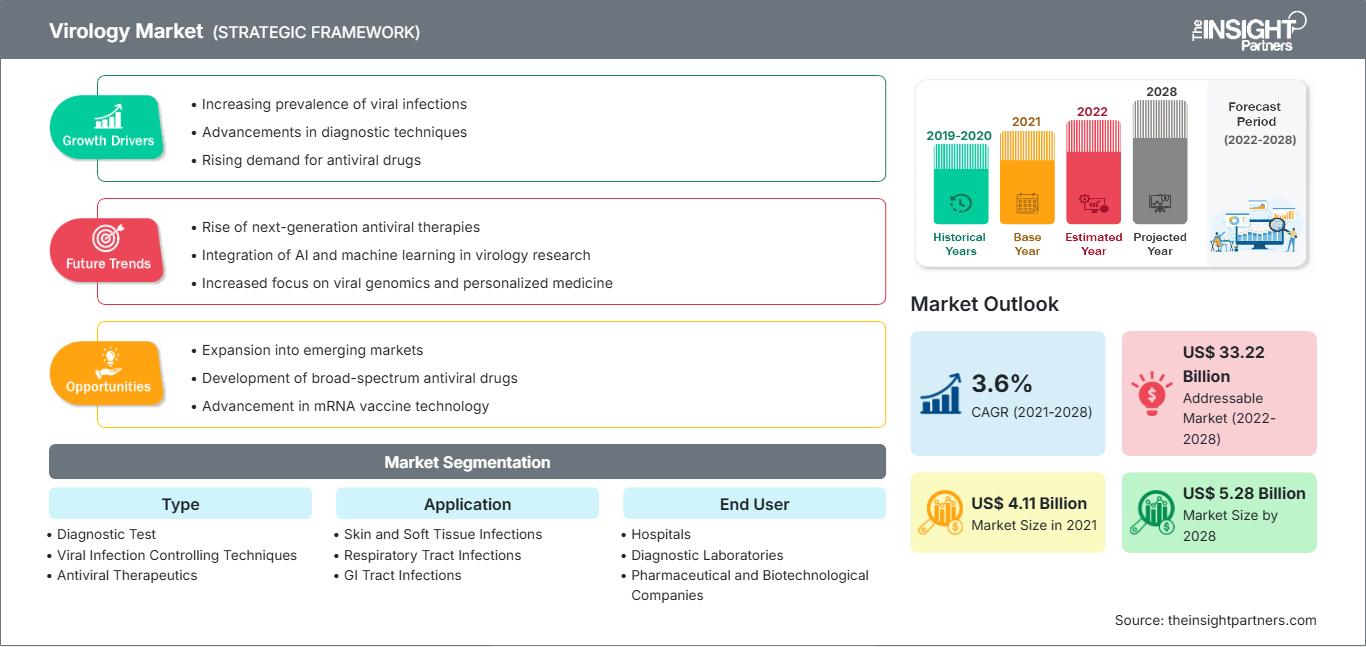Le marché de la virologie devrait atteindre 5 276,48 millions de dollars américains d'ici 2028, contre 4 108,27 millions de dollars américains en 2021 ; il devrait enregistrer un TCAC de 3,6 % de 2021 à 2028.
- En août 2021, la Food and Drug Administration (FDA) américaine a approuvé le premier vaccin contre la COVID-19, connu sous le nom de vaccin Pfizer-BioNTech contre la COVID-19. Il sera commercialisé sous le nom de ComiRNAty (Koe-mir’-na-tee). Ce vaccin est destiné à prévenir la maladie COVID-19 chez les personnes âgées de 16 ans et plus. Il est également disponible sous autorisation d'utilisation d'urgence (EUA).
- En avril 2021, CerTest Biotec a lancé son test de diagnostic COVID-19 marqué CE pour le système BD MAX.
- En mai 2020, Bio-Rad a reçu l'approbation de la FDA pour une autorisation d'utilisation d'urgence pour le test d'anticorps totaux COVID-19.
- En mai 2020, Aalto Bio Reagents a lancé de nouvelles protéines de pointe eucaryotes recombinantes SARS-CoV-2 S1-S2.
Personnalisez ce rapport en fonction de vos besoins
Vous bénéficierez d’une personnalisation sur n’importe quel rapport - gratuitement - y compris des parties de ce rapport, ou une analyse au niveau du pays, un pack de données Excel, ainsi que de profiter d’offres exceptionnelles et de réductions pour les start-ups et les universités
Marché de la virologie: Perspectives stratégiques

- Obtenez les principales tendances clés du marché de ce rapport.Cet échantillon GRATUIT comprendra une analyse de données, allant des tendances du marché aux estimations et prévisions.
Vous bénéficierez d’une personnalisation sur n’importe quel rapport - gratuitement - y compris des parties de ce rapport, ou une analyse au niveau du pays, un pack de données Excel, ainsi que de profiter d’offres exceptionnelles et de réductions pour les start-ups et les universités
Marché de la virologie: Perspectives stratégiques

- Obtenez les principales tendances clés du marché de ce rapport.Cet échantillon GRATUIT comprendra une analyse de données, allant des tendances du marché aux estimations et prévisions.
Aperçu du marché
L'adoption croissante des procédures esthétiques mini-invasives et non invasives stimule la croissance du marché de la virologie
Marché de la virologie
Les tendances régionales et les facteurs influençant le marché de la virologie tout au long de la période de prévision ont été analysés en détail par les analystes de The Insight Partners. Cette section aborde également les segments et la géographie du marché de la virologie en Amérique du Nord, en Europe, en Asie-Pacifique, au Moyen-Orient et en Afrique, ainsi qu'en Amérique du Sud et en Amérique centrale.
Portée du rapport sur le marché de la virologieDensité des acteurs du marché de la virologie : comprendre son impact sur la dynamique commerciale
Le marché de la virologie connaît une croissance rapide, portée par une demande croissante des utilisateurs finaux, due à des facteurs tels que l'évolution des préférences des consommateurs, les avancées technologiques et une meilleure connaissance des avantages du produit. Face à cette demande croissante, les entreprises élargissent leur offre, innovent pour répondre aux besoins des consommateurs et capitalisent sur les tendances émergentes, ce qui alimente la croissance du marché.
- Obtenez le Marché de la virologie Aperçu des principaux acteurs clés
Informations basées sur le type
Informations basées sur les applications
Marché de la virologie – Segmentation
Par type
- Test de diagnostic
- Test de virus ADN
- Test de virus ARN
- Autres
- Techniques de contrôle des infections virales
- Prophylaxie active
- Prophylaxie passive
- Thérapeutiques antiviraux
- Agents virucides
- Agents antiviraux
- Immunomodulateurs
- Interférons
Par application
- Infections de la peau et des tissus mous
- Infections des voies respiratoires
- Infections du tractus gastro-intestinal
- Transmissibles sexuellement Maladies
- Infections des voies urinaires
- Autres
Par utilisateur final
- Hôpitaux
- Laboratoires de diagnostic
- Sociétés pharmaceutiques et biotechnologiques
- Instituts de recherche et universitaires
Par géographie
- Amérique du Nord
- États-Unis
- Canada
- Mexique
- Europe
- France
- Allemagne
- Italie
- Royaume-Uni
- Espagne
- Reste de l'Europe
- Asie-Pacifique
- Chine
- Inde
- Sud Corée
- Japon
- Australie
- Reste de l'APAC
- Moyen-Orient et Afrique
- Afrique du Sud
- Arabie saoudite
- Émirats arabes unis
- Reste de la région MEA
- Amérique du Sud et centrale
- Brésil
- Argentine
- Reste de la région SCAM
Profils d'entreprise
- Abbott
- Johnson & Johnson Services, Inc.
- F. Hoffmann-LA Roche Ltd.
- Thermo Fisher Scientific, Inc.
- Qiagen
- Illumina, Inc.
- Siemens AG
- GlaxoSmithKline Plc
- Gilead Sciences, Inc.
- AbbVie, Inc. noms de droits d'auteur indiqués sur les sites Web respectifs.
- Analyse historique (2 ans), année de base, prévision (7 ans) avec TCAC
- Analyse PEST et SWOT
- Taille du marché Valeur / Volume - Mondial, Régional, Pays
- Industrie et paysage concurrentiel
- Ensemble de données Excel
Rapports récents
Témoignages
Raison d'acheter
- Prise de décision éclairée
- Compréhension de la dynamique du marché
- Analyse concurrentielle
- Connaissances clients
- Prévisions de marché
- Atténuation des risques
- Planification stratégique
- Justification des investissements
- Identification des marchés émergents
- Amélioration des stratégies marketing
- Amélioration de l'efficacité opérationnelle
- Alignement sur les tendances réglementaires




















 Obtenez un échantillon gratuit pour - Marché de la virologie
Obtenez un échantillon gratuit pour - Marché de la virologie